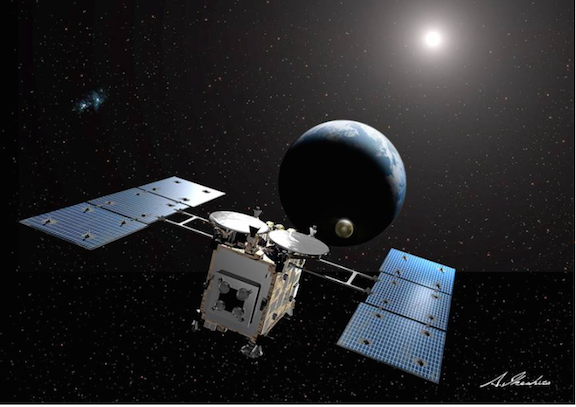
[Satnews] Electric thrusters are weaker than chemical-based engines but boast higher efficiency and consume only about one-fifth of the fuel...
The Japan Aerospace Exploration Agency (JAXA) is studying the feasibility of using electric propulsion in artificial satellites beginning in fiscal 2021 to save fuel and improve performance.

Electric thrusters like those shown in this illustration of the Hayabusa2 Astroid Explorer are gaining traction as a way to replace engines driven by bulky chemical propellants. | JAXA / KYODO
“We aim to make dramatic technological advances as satellites are important for Japan,” a JAXA official said.
Competition is intense for making communications and broadcast satellites, which take geostationary orbits about 36,000 km (22,369 miles) above Earth’s equator.
Satellites use their own engines to get into orbit and control themselves. Since their chemical propellants can account for as much as half a satellite’s weight, limiting equipment space, ion engine technology and other forms of electric propulsion are being pursued.
Electric thrusters are weaker than chemical-based engines but boast higher efficiency and consume only about one-fifth of the fuel. The Hayabusa spacecraft, which harvested particles from asteroid Itokawa and brought them back to Earth in June 2010, used an ion engine to complete the seven-year voyage.
U.S. and European manufacturers are leading the development of electric engines, but JAXA could start development in fiscal 2016 starting next April if its budget is approved.
“Without this technology, we will not be able to compete in the market,” said Yasushi Hatooka, planning manager at JAXA’s Research Strategy Department.
Boosting thruster propulsion is a major challenge. A geostationary satellite powered by a conventional chemical engine takes several days to place in orbit after separation from the rocket, but several months if powered by an electric thruster, according to Hatooka.
JAXA plans to adopt a type of ion engine called a “Hall effect” thruster, which can generate more power than typical ion thrusters. It wants to achieve one of the highest power levels in the world for this type of propulsion.
If all goes well, JAXA hopes to use electric propulsion in a satellite to be launched in fiscal 2021 on the next-generation H3 rocket, which is under development.
“Electric propulsion is a technology we have to acquire,” Hatooka said. “The mission to develop new technology is very challenging for an engineer.”
Story from Japan Times

